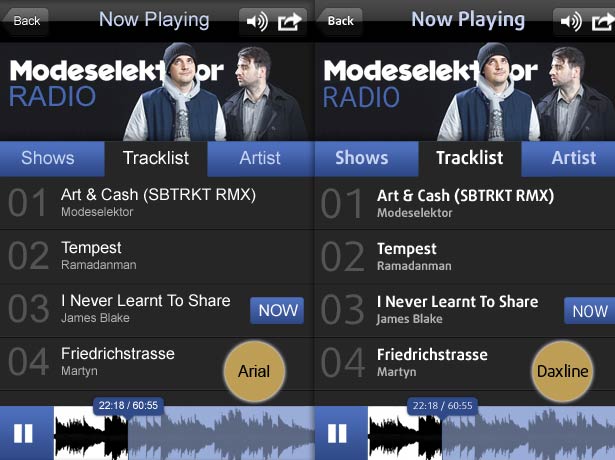Why native app fonts still suck
The next big typography challenge is already looming on the horizon: fonts for mobile devices. But again, there are a myriad of special considerations involved. FontFont's Ivo Gabrowitsch takes the mystery out of native app font licensing
Heads up, typography fans: just when you thought you’d gotten used to web fonts, fonts for apps and mobile devices are already looming on the horizon. This is great news for anyone who loves beautiful design, but like web fonts, mobile fonts involve a number of special considerations, including legal issues that need to be addressed by the industry.
In July of 2011, Apple announced that they reached a whopping 15billion app downloads. With half a million apps available on the App Store and more being added every day, we can certainly expect to see a few billion more downloads by the end of this year. While countless multitudes of apps cover every imaginable concept and need, they have one basic design flaw in common: all of them are limited to using one of only 50 system fonts available in iOS. Sad but true, no matter whether they’re creating “fun” apps for gaming and entertainment or “serious” apps for work, developers can only choose from a tiny pool of omnipresent typefaces such as Arial, Times New Roman, Trebuchet and a handful of others. From a typographic standpoint, the pickings are slim indeed in the mobile world. It was not until the release of iOS 3.2 that it even became technically possible to embed any available font in an app, giving developers and designers a much needed option to break away from the monotony of iOS-enforced typography.

So why do we still settle for Helvetica et al on our iPhones? With the increasing need to stand out in a cluttered information landscape, more and more developers are striving to give their apps or e-publications a more distinctive and elegant look. But where custom artwork and embedded fonts are called for, their lofty design intentions are often quashed by complicated licensing conditions. Like music and images, fonts are commercial products for professional use and are often restricted by standard user licenses that forbid users from embedding them in apps.
Font restrictions
Why the restrictions? There are several reasons. First, fonts are usually embedded in a way that allows end-users some kind of interactive use, for example text editing. This type of usage gives real added value to the user, so naturally it’s subject to additional licensing fees to the designer or foundry. On top of this, there are security concerns. For example, the current embedding method does not really protect the fonts from unauthorised access, making type designers and manufacturers potentially vulnerable to financial loss and coypright violations. Of course most end-user licenses include a clause requiring secure embedding to protect the designer’s intellectual property, but this is no real guarantee against abuse. So, while a few foundries strictly forbid non-secure embedding, most now do permit it, but at the cost of an additional license fee for embedding.
This is where special licenses such as ‘Editable Embedding Licenses’ or ‘Device Licenses’ come into play. Prices vary considerably, starting at triple-digit figures and going as high as quadruple-digit figures per font for unlimited usage. Developers should read the fine print carefully, since licensing details may differ radically depending on several factors. Some font manufacturers calculate their prices for an unlimited period of time for one or more versions of an app for all platforms, while others grant a time-limited license for specific mobile platforms. Test-bubbles abound, and it may take a little time for the industry to agree on a standard. So even after reading the EULA, you will still probably end up contacting the foundry and enquiring about individual conditions. The good news is: you might be surprised at how flexible some foundries are at this early stage in the history of app font licensing.
There are also vendors that are actively responding to the new needs of users and developers by offering new tailored license models. For example, The Font Bureau permits users to embed any of their fonts in single or multiple apps on single or multiple platforms. Their price is based on the number of fonts, apps and systems. For example, if you want an unlimited license to embed four weights of a family (for example, Regular, Italic, Bold and Bold Italic) into a specified app in one operating system, it will cost you $3,500.
Simplified licensing
In an effort to provide an affordable alternative, FontShop International even created a whole new product range of 15 font families that can be licensed as Mobile FontFonts, with a simple license agreement based on the offline user license model. This one-time licensing fee covers up to five developers, permitting them to embed four weights of a Mobile FontFont family, and starts at $179. Currently, this simplified mobile licensing is aimed exclusively at Apple iOS developers, but will later expand to cover other mobile operating systems like Android.
Until the industry reaches a consensus, new and changing licensing models will continue to cause confusion for a while. This may not be such a big problem for large companies who use their apps as a new marketing channel, rather than a direct revenue stream. Since the purpose is to disseminate their products and identity, they won’t mind paying hefty licensing fees in order to brand their apps with their own corporate typefaces. For small-budget developers, it’s an entirely different story. But even they won’t have to settle for system fonts for long, since the type industry will eventually catch up with the new market conditions. Soon we can look forward to more flexible special licensing conditions, new product categories or new license types for existing fonts.
Why? Because the bottom line is that type foundries are also eager to see their typefaces on mobile devices – but with proper licensing.
Daily design news, reviews, how-tos and more, as picked by the editors.

The Creative Bloq team is made up of a group of art and design enthusiasts, and has changed and evolved since Creative Bloq began back in 2012. The current website team consists of eight full-time members of staff: Editor Georgia Coggan, Deputy Editor Rosie Hilder, Ecommerce Editor Beren Neale, Senior News Editor Daniel Piper, Editor, Digital Art and 3D Ian Dean, Tech Reviews Editor Erlingur Einarsson, Ecommerce Writer Beth Nicholls and Staff Writer Natalie Fear, as well as a roster of freelancers from around the world. The ImagineFX magazine team also pitch in, ensuring that content from leading digital art publication ImagineFX is represented on Creative Bloq.
